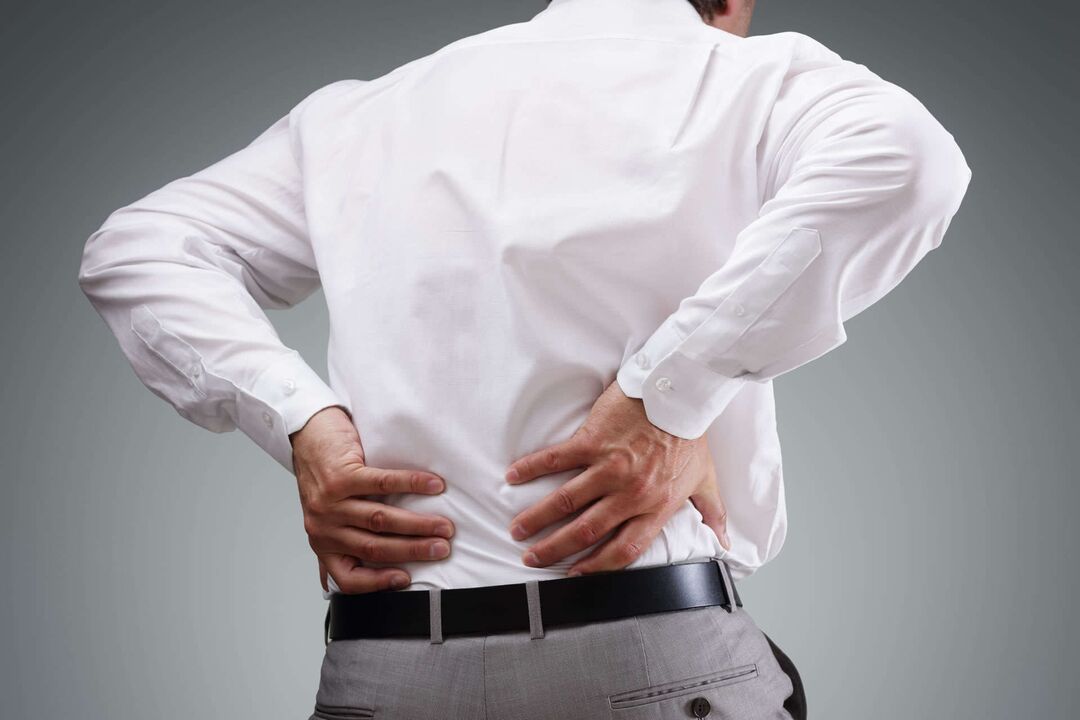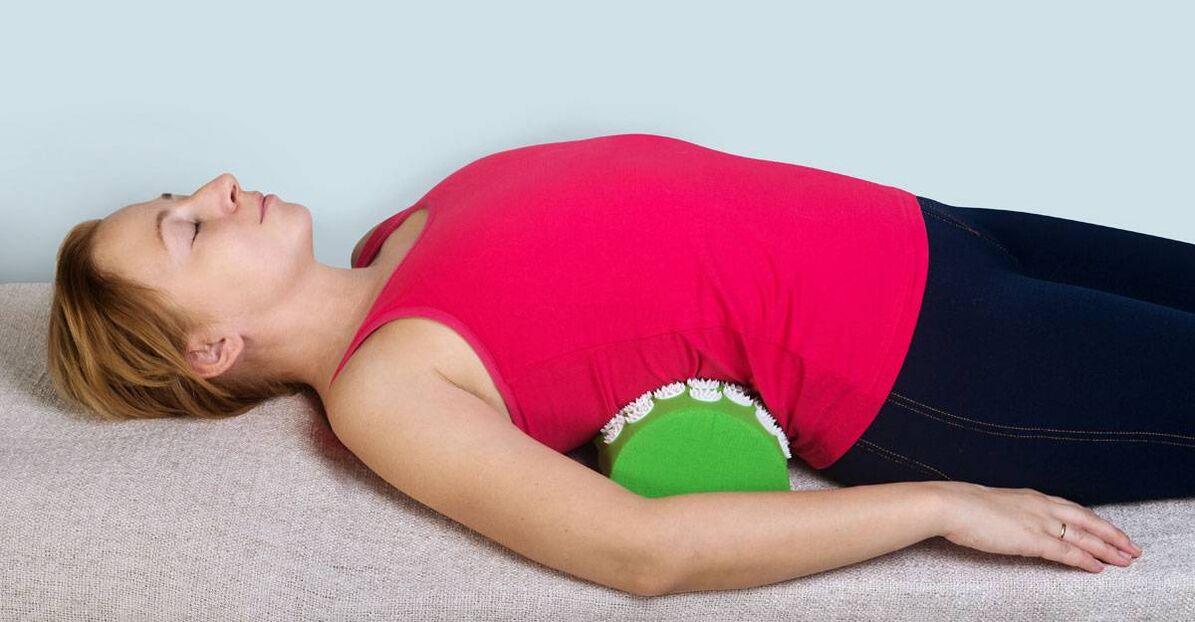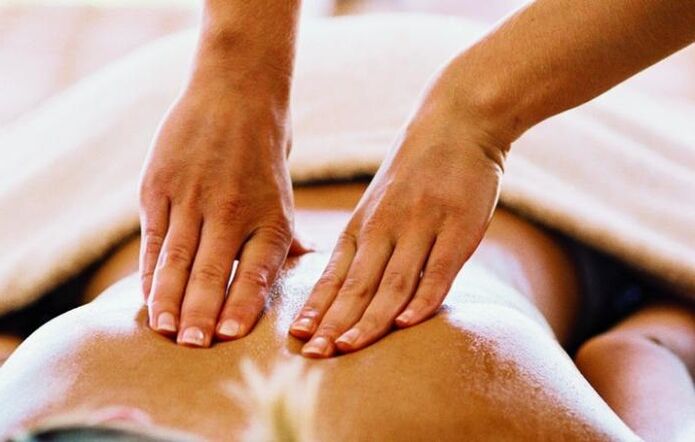With osteochondrosis of the spine, bone tissue and cartilage in one or more parts of the spine are destroyed. This disease is chronic and develops in almost all elderly people. This is due to the normal aging of the body.

Intervertebral discs undergo atrophic changes and the age at which this happens depends on many factors:
- trauma;
- spinal diseases and overload.
Column overload includes:
- walking with a bent back;
- improper session;
- characteristics of the structure of the spine;
- insufficient nutrition of spinal tissues due to hereditary abnormalities.
With osteochondrosis, the nucleus located between the vertebral discs loses some of its water. Because of this, metabolic disturbances occur in the core and access to various minerals and vitamins is difficult.
After a while, cracks appear on the disk, it becomes flat. Then the nearby joints and ligaments begin to be affected, causing tissue inflammation. Due to inflammation, the adjacent vertebrae are displaced. This is dangerous with the appearance of radicular symptoms: pain along the affected nerve.
An intervertebral hernia is also possible, and this in turn can cause spinal cord compression. Osteochondrosis is characterized by the appearance of osteophytes - bone growths in the vertebral bodies. These growths can compress the spinal cord and cause radicular syndrome.
Most of the time, the cervical and lumbar regions are susceptible to osteochondrosis.
Cervical osteochondrosis
Causes:
- sports activities (weight lifting);
- overweight;
- metabolic disease;
- sedentary work (programmers, accountants, drivers, etc. );
- flat foot;
- spinal injury;
- hypothermia.
Symptoms
The main symptoms of osteochondrosis of the cervical spine are pain in the head and neck. A person is preoccupied with severe headaches, pain in the neck, radiating to the arm, pain in the sternum. The patient may complain of lumbago - the onset of sharp pain in the neck, muscle spasm and restriction of movement.
Also, a person may hear a snap when turning their neck. Due to pinched nerves and blood vessels, a person may experience numbness of the tongue and fingertips. The patient will complain of decreased hearing and vision, hypertension and weakness in the muscles of the arms and legs.
Thoracic osteochondrosis
This type of osteochondrosis is quite rare. This is due to the anatomical structure of the thoracic spine. It consists of 12 vertebrae, which are connected to the ribs through joints. At the front, the ribs are connected to each other by the sternum. Thus, an excellent structure of the spine, sternum and ribs is created, which protects the internal organs from various injuries.
The vertebrae in the thoracic region are short in height and have long spiny processes, which are located one above the other, like gravel. Because of this structure, this part of the spine has low mobility. Intervertebral discs in the thoracic region are rarely injured.
The reasons for the formation of this type of osteochondrosis:
- irrational load distribution;
- delay in intervertebral disc nutrition;
- sedentary work;
- the presence of scoliosis.
Symptoms
As with other types, pain is the main symptom of thoracic osteochondrosis.
But with thoracic osteochondrosis, the pain can be different. Back pain - prolonged discomfort and mild pain along the thoracic vertebrae. Pain can affect the cervical and lumbar regions.
Dorsago is one of the signs of thoracic osteochondrosis, in which pain occurs in the form of a crisis. By its nature, it is intense, acute, leads to difficulty in breathing and leads to restriction of muscle movement. In addition to pain, patients may experience numbness in the chest, decreased sexual function, pain in the heart, kidneys, and stomach.
What is the danger of affecting the thoracic region?
The spine is designed so that it narrows in the thoracic region so that hernias resulting from osteochondrosis quickly lead to compression of the spinal cord. This can easily lead to heart, pancreas, liver and kidney problems because the chest region is connected to all these organs by nerve fibers. That's why it's very important to see a doctor at the right time. It will help you to find out where the signs of osteochondrosis that trouble you are coming from and provide competent treatment for the disease.
lumbar osteochondrosis
Osteochondrosis of the lumbar spine occurs due to weight lifting. Normally, at the center of the intervertebral disc is a nucleus containing a large amount of water. Due to the liquid, the core becomes slightly compressible and, for its rupture, a compression of 500 kg is necessary.
However, the disc affected by osteochondrosis becomes weaker, requiring only 200 kg to break it. If a person weighing 70 kg lifts 15 kg of load in a bent position, and for the spine this is a 200 kg load, the intervertebral disc may rupture. This is why the first symptoms of spinal osteochondrosis appear when lifting weights.
Symptoms
- pain in the lower back;
- inability to move in the lower back;
- sleep disorders;
- irritability;
- fatigue;
- inability to meet domestic needs;
- decreased sexual function in men;
- violation of the menstrual cycle;
- cold feet syndrome.
With the transition from osteochondrosis to the sacral region, the patient develops pain in the kidney region and violation of urination.
Diagnosis
Osteochondrosis is treated by a neurologist. To begin with, he examines the spine, drawing attention to the presence of scoliosis. After feeling it, the doctor will be able to understand how it affected the spine, tendons and nerves.
Once the neurologist suspects spinal osteochondrosis, he will refer the patient for further testing. This includes passing an X-ray and MRI scan. If destruction of the intervertebral disc is suspected, discography is performed. It is also prescribed to determine the degree of damage to nerve pathways.
In general, it is very difficult to diagnose osteochondrosis of the spine. After all, a person may complain of pain in the heart, liver, kidneys, pancreas or sexual dysfunction. Even so, with close examination, an experienced doctor will be able to suspect the disease and prescribe the correct treatment.
Treatment
Osteochondrosis therapy is a very long and difficult process. In the acute period, the patient needs the rest of the affected segment. If the cervical spine is affected, the patient should wear a Shants Fixation Collar. If the lumbar spine hurts, the patient needs bed rest. It's better to put the patient in a hospital. Only then will you be able to fully comply with the assigned regime. Such a patient's bed must be hard. For this, a wooden plank is placed under the mattress.
drug treatment
As mentioned above, the main symptom of the disease is pain. Therefore, analgesics and non-steroidal anti-inflammatory drugs are prescribed to relieve pain and other symptoms of osteochondrosis.
Unfortunately, long-term use of these drugs causes damage to the mucous membrane of the gastrointestinal tract and the patient develops the following symptoms:
- nausea;
- to vomit;
- stomachache;
- a feeling of heaviness in the abdomen.
The stomach ulcer may also get worse or stomach bleeding may occur. Therefore, before using these medications, you should consult your doctor. If the pain caused by osteochondrosis lasts for 3 months, antidepressants are prescribed along with these medications. It was found that, in addition to the sedative effect, they are able to reduce pain.
All medications can be classified as symptomatic therapy. They help alleviate pain, but they don't rid the person of the illness itself.
Chondroprotectors are prescribed to restore intervertebral discs and cartilage. These drugs improve connective tissue metabolism and help restore cartilage. The medications are taken for a long period of time, on average - 4 to 6 months.
In addition to restoring tissues and improving their metabolism, these drugs also have an analgesic effect. Another group of medications needed for osteochondrosis of the spine are medications that improve blood circulation, their use helps to expand blood vessels, and if thioctic acid is taken in combination with it, a person's nerve cell metabolism will improve.
As with any disease, patients need calcium supplements. It will restore bone tissue activity, increase ligament and tendon strength, and also prevent osteoporosis - a disease that accompanies osteochondrosis.
Physiotherapy

The metered load on the spine will improve the patient's condition. But you need to perform the exercises with extreme care. In the acute period, physical education is contraindicated. Only when the pain sensations subside can you start to practice a little.
Exercise improves blood circulation in the spine and strengthens muscles. Due to the blood flow, metabolism will improve and restoration of the damaged intervertebral discs will begin. But you must also remember that classes must be held regularly, otherwise there will be no result.
Exercises for cervical spine injuries
- Lie on your back and straighten up. Place one hand on your stomach and the other on your chest and inhale, hold your breath for 10 minutes, exhale and relax. The exercise duration is 3 to 5 minutes. You need to do this 3-5 times a day.
- Lie on your stomach and straighten your legs. Resting on your belly and legs, you need to lift your head and upper chest. Do the exercise for 3-5 minutes with a 30-second break.
- Lie on your back and bend your knees. In this position, turn to the right and left side. Do the exercise for 3-5 minutes with a 30-second break.
Exercises for thoracic region injuries
- Lie down on your stomach. Place your hands on the floor and lean back. Hold this position for 5-10 seconds. Do the exercise for 3-5 minutes with a 20-second break.
- Lay on your back. Raise your head and legs ("boat"). Hold for 10-20 seconds. Do the exercise for 3-5 minutes with a 20-second break.
Exercises for Lumbar Spine Injuries
- Lie on your back, bend your knees and bring them to your chest. Rock back and forth and roll back and forth into the sacrum. Shake up to 2 minutes. Then you need to lie down calmly and relax.
- You need to get on all fours and bend over as much as possible. Do the exercise for 3-5 minutes with a 20-second break.
- Standing, imagine rotating the bow for 2-3 minutes. Exercise 10 times a day.
Surgery
In the absence of the effect of conservative treatment and the emergence of complications from osteochondrosis, surgical treatment is prescribed. During spinal stabilization, pressure on the spinal cord and roots is relieved. If a person has an intervertebral hernia, it is removed. Since this operation can damage the spinal cord and nerves, it is performed for vital reasons only.
physiotherapeutic treatment
Scheduling physical therapy procedures has a positive effect on the course of the disease and speeds up the recovery process. With osteochondrosis, it is allowed:

- visiting a sauna or bath;
- swim in the pool;
- massage;
- paraffin therapy;
- manual therapy;
- laser therapy;
- multiple baths;
- mud therapy;
- electrophoresis with anti-inflammatory drugs or muscle relaxants;
- magnetotherapy;
- darsonval.
All these procedures improve blood circulation in the diseased area, allow the muscles to relax and relax the entire body. Physical therapy procedures are prescribed during the rehabilitation period, when the patient is not bothered by severe pain.
Prophylaxis
Nobody is immune to osteochondrosis. After all, we all grow old, and our entire body also ages with us. So that the disease doesn't spoil your plans, you need to play sports from an early age. Moderate physical activity improves blood circulation, normal metabolism. It also trains the muscles that protect the spine. To prevent osteochondrosis, each person must:
- eat well - vitamins and minerals needed by the body;
- refuse from bad habits;
- get involved in physical education;
- don't neglect;
- protect your back from hypothermia;
- do not lift very heavy objects;
- take a shower of contrast and temper;
- avoid stress.
It is especially important for people with this disease to follow all the recommendations, because failure will lead to an exacerbation. If you have back pain that doesn't go away for a long time, it is necessary to seek the help of an expert. Only a doctor can make the correct diagnosis and prescribe treatment.
Don't delay going to the clinic, as it is better to treat the disease in the early stages. Also, don't self-medicate - any medication has its own contraindications, which you may not know about. Strictly follow all the doctor's recommendations and the disease will soon regress!












































